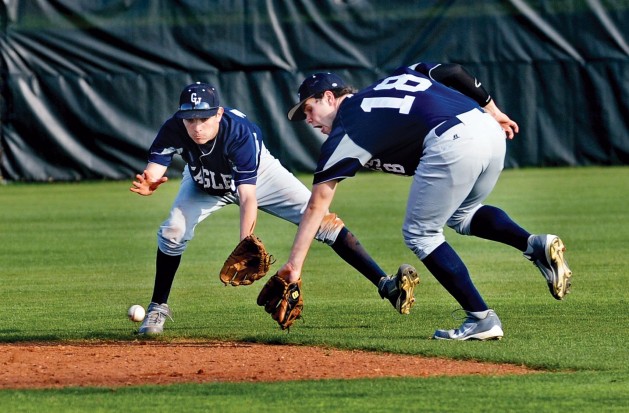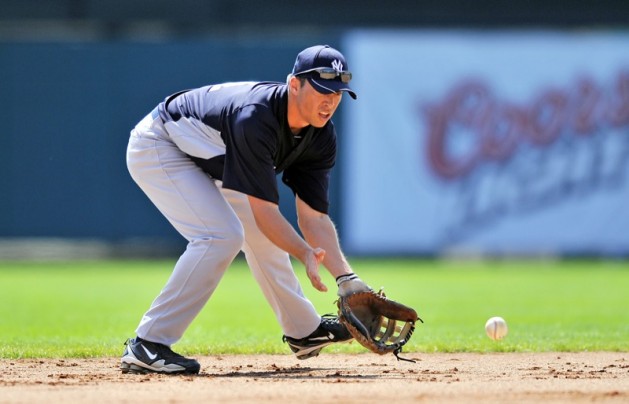Practice This Winter With Indoor Baseball Fielding Drills
Spring training is around the corner. As teams begin pre-season practices, many will be confined indoors with limited space to perform drills.
Infield drills are among the easiest drills to perform in a confined space. The indoor baseball drills below require only 50 to 60 feet and are a great way to get started on your defensive practice this winter.
Indoor Baseball Fielding Drills
Short Hops
Your partner throws you a short hop from approximately five to seven feet away. With your feet planted, work your glove from its ready position towards the ball, and field it off the short hop. Your wrist should remain loose, and you should show your palm to the ball. Keep your head and eyes locked on the ball as you look it into your glove. Your throwing hand should be directly above your glove with your fingers pointing to the sky. To prevent them from getting in the way, do not to let your fingers dangle near the heel or pocket of your glove. (Learn how to improve your backhand technique.)
Sets/Reps: 1×10 forehand and backhand
Rapid Fire Short Hops
Follow the same setup as above, but field the ball with your bare hand. Have your partner toss the short hops at a rapid pace.
Sets/Reps: 1×10 forehand and backhand
Wall Ball
Form a line with three to four other fielders about 30 to 45 feet away from a wall (increase distance for an added challenge). First player throws the ball against the wall, catches it and makes a second throw. Second player in line catches the ball and throws it against the wall. Continue this pattern for the specified time. For an added challenge, add a second ball or place a mark on the wall to encourage throwing accuracy.
Sets/Time: 1×30-60 seconds
Double-Duty Double Play

Form a line with three to four fielders 30 to 45 feet away from a wall corner. First player throws the ball off the right wall, fields it, swings the gate (see below) and throws to the left. Next player in line fields the ball, jump pivots and throws to the right. Continue this alternating pattern for the specified time. This can be performed solo for an additional challenge.
Sets/Time: 1×30-60 seconds
Jump Pivot: Field the ball in front of your body with your hands just to the right (inside) of your left foot. Swing your hands to your throwing side as you transfer the ball to your throwing hand. This action will trigger your lower half and allow your hips to open and get square to second base.
Swing the Gate: This feed is best used on balls hit to your right that you can still get in front of, but you are too far from second base to make a strong and accurate underhand flip. Field the ball out in front of your body with your hands just to the left (inside) of your right foot. This will cut down the distance your hands (and the ball) travel during the transfer. Staying low to the ground, swing your left foot open and square your shoulders to second base to make the throw. It’s important to stay low to the ground and throw from the same angle the ball was fielded.
To improve your outfielding skills, check out these two articles (Part 1, Part 2) on the crow hop technique.
RECOMMENDED FOR YOU
MOST POPULAR
Practice This Winter With Indoor Baseball Fielding Drills
Spring training is around the corner. As teams begin pre-season practices, many will be confined indoors with limited space to perform drills.
Infield drills are among the easiest drills to perform in a confined space. The indoor baseball drills below require only 50 to 60 feet and are a great way to get started on your defensive practice this winter.
Indoor Baseball Fielding Drills
Short Hops
Your partner throws you a short hop from approximately five to seven feet away. With your feet planted, work your glove from its ready position towards the ball, and field it off the short hop. Your wrist should remain loose, and you should show your palm to the ball. Keep your head and eyes locked on the ball as you look it into your glove. Your throwing hand should be directly above your glove with your fingers pointing to the sky. To prevent them from getting in the way, do not to let your fingers dangle near the heel or pocket of your glove. (Learn how to improve your backhand technique.)
Sets/Reps: 1×10 forehand and backhand
Rapid Fire Short Hops
Follow the same setup as above, but field the ball with your bare hand. Have your partner toss the short hops at a rapid pace.
Sets/Reps: 1×10 forehand and backhand
Wall Ball
Form a line with three to four other fielders about 30 to 45 feet away from a wall (increase distance for an added challenge). First player throws the ball against the wall, catches it and makes a second throw. Second player in line catches the ball and throws it against the wall. Continue this pattern for the specified time. For an added challenge, add a second ball or place a mark on the wall to encourage throwing accuracy.
Sets/Time: 1×30-60 seconds
Double-Duty Double Play

Form a line with three to four fielders 30 to 45 feet away from a wall corner. First player throws the ball off the right wall, fields it, swings the gate (see below) and throws to the left. Next player in line fields the ball, jump pivots and throws to the right. Continue this alternating pattern for the specified time. This can be performed solo for an additional challenge.
Sets/Time: 1×30-60 seconds
Jump Pivot: Field the ball in front of your body with your hands just to the right (inside) of your left foot. Swing your hands to your throwing side as you transfer the ball to your throwing hand. This action will trigger your lower half and allow your hips to open and get square to second base.
Swing the Gate: This feed is best used on balls hit to your right that you can still get in front of, but you are too far from second base to make a strong and accurate underhand flip. Field the ball out in front of your body with your hands just to the left (inside) of your right foot. This will cut down the distance your hands (and the ball) travel during the transfer. Staying low to the ground, swing your left foot open and square your shoulders to second base to make the throw. It’s important to stay low to the ground and throw from the same angle the ball was fielded.
To improve your outfielding skills, check out these two articles (Part 1, Part 2) on the crow hop technique.













